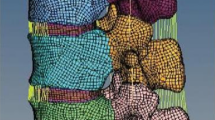Abstract
Thoracolumbar spine fracture classifications are mainly based on a post-traumatic observation of fracture patterns, which is not sufficient to provide a full understanding of spinal fracture mechanisms. This study aimed to biomechanically analyze known fracture patterns and to study how they relate to fracture mechanisms. The instigation of each fracture type was computationally simulated to assess the fracture process. A refined finite element model of three vertebrae and intervertebral connective tissues was subjected to 51 different dynamic loading conditions divided into four categories: compression, shear, distraction and torsion. Fracture initiation and propagation were analyzed, and time and energy at fracture initiation were computed. To each fracture pattern described in the clinical literature were associated one or several of the simulated fracture patterns and corresponding loading conditions. When compared to each other, torsion resulted in low-energy fractures, compression and shear resulted in medium energy fractures, and distraction resulted in high-energy fractures. Increased velocity resulted in higher-energy fracture for similar loadings. The use of a finite element model provided quantitative characterization of fracture patterns occurrence complementary to clinical and experimental studies, allowing to fully understand spinal fracture biomechanics.





Similar content being viewed by others
References
Buckley JM, Leang DC, Keaveny TM (2006) Sensitivity of vertebral compressive strength to endplate loading distribution. J Biomech Eng 128(5):641–646
Denis F (1983) The three column spine and its significance in the classification of acute thoracolumbar spinal injuries. Spine (Phila Pa 1976) 8(8):817–831
Duma SM et al (2006) Biomechanical response of the lumbar spine in dynamic compression. Biomed Sci Instrum 42:476–481
Eguizabal J et al (2010) Pure moment testing for spinal biomechanics applications: fixed versus sliding ring cable-driven test designs. J Biomech 43(7):1422–1425
El-Rich M et al (2009) Finite element investigation of the loading rate effect on the spinal load-sharing changes under impact conditions. J Biomech 42(9):1252–1262
Garges KJ et al (2008) A comparison of the torsional stiffness of the lumbar spine in flexion and extension. J Manip Physiol Ther 31(8):563–569
Garo A et al (2011) Calibration of the mechanical properties in a finite element model of a lumbar vertebra under dynamic compression up to failure. Med Biol Eng Comput 49(12):1371–1379
Holdsworth F (1970) Fractures, dislocations, and fracture-dislocations of the spine. J Bone Joint Surg Am 52(8):1534–1551
Kemper AR, McNally C, Duma SM (2007) The influence of strain rate on the compressive stiffness properties of human lumbar intervertebral discs. Biomed Sci Instrum 43:176–181
Kifune M et al (1997) Functional morphology of the spinal canal after endplate, wedge, and burst fractures. J Spinal Disord 10(6):457–466
Lalonde NM et al (2010) Biomechanical modeling of the lateral decubitus posture during corrective scoliosis surgery. Clin Biomech (Bristol, Avon) 25(6):510–516
Leucht P et al (2009) Epidemiology of traumatic spine fractures. Injury 40(2):166–172
Little JP, Adam CJ (2009) The effect of soft tissue properties on spinal flexibility in scoliosis: biomechanical simulation of fulcrum bending. Spine (Phila Pa 1976) 34(2):E76–E82
Magerl F et al (1994) A comprehensive classification of thoracic and lumbar injuries. Eur Spine J 3(4):184–201
Neumann P, Nordwall A, Osvalder AL (1995) Traumatic instability of the lumbar spine. A dynamic in vitro study of flexion-distraction injury. Spine (Phila Pa 1976) 20(10):1111–1121
Osvalder AL et al (1993) A method for studying the biomechanical load response of the (in vitro) lumbar spine under dynamic flexion-shear loads. J Biomech 26(10):1227–1236
Oxland T et al (2011) Biomechanical aspects of spinal cord injury. In: Bilston LE (ed) Neural tissue biomechanics. Springer, Berlin, pp 159–180
Panjabi MM (2007) Hybrid multidirectional test method to evaluate spinal adjacent-level effects. Clin Biomech (Bristol, Avon) 22(3):257–265
Panjabi MM et al (1998) Graded thoracolumbar spinal injuries: development of multidirectional instability. Eur Spine J 7(4):332–339
Qiu TX et al (2006) Investigation of thoracolumbar T12-L1 burst fracture mechanism using finite element method. Med Eng Phys 28(7):656–664
Vaccaro AR et al (2005) A new classification of thoracolumbar injuries: the importance of injury morphology, the integrity of the posterior ligamentous complex, and neurologic status. Spine (Phila Pa 1976) 30(20):2325–2333
Wagnac E et al (2012) Finite element analysis of the influence of loading rate on a model of the full lumbar spine under dynamic loading conditions. Med Biol Eng Comput 50(9):903–915
Wagnac E et al (2011) Calibration of hyperelastic material properties of the human lumbar intervertebral disc under fast dynamic compressive loads. J Biomech Eng 133(10):101007
Whyne CM, Hu SS, Lotz JC (2003) Burst fracture in the metastatically involved spine: development, validation, and parametric analysis of a three-dimensional poroelastic finite-element model. Spine (Phila Pa 1976) 28(7):652–660
Wilcox RK et al (2004) A dynamic investigation of the burst fracture process using a combined experimental and finite element approach. Eur Spine J 13(6):481–488
Yogonandan N et al (1989) Stiffness and strain energy criteria to evaluate the threshold of injury to an intervertebral joint. J Biomech 22(2):135–142
Acknowledgments
This work was funded by the “Fondation Canadienne pour l’innovation” (FCI), the “Conseil de Recherche en Sciences Naturelles en Génie” (CRSNG) and the “Institut français des sciences et technologies des transports, de l’aménagement et des réseaux” (IFSTTAR).
Author information
Authors and Affiliations
Corresponding author
Rights and permissions
About this article
Cite this article
Fradet, L., Petit, Y., Wagnac, E. et al. Biomechanics of thoracolumbar junction vertebral fractures from various kinematic conditions. Med Biol Eng Comput 52, 87–94 (2014). https://doi.org/10.1007/s11517-013-1124-8
Received:
Accepted:
Published:
Issue Date:
DOI: https://doi.org/10.1007/s11517-013-1124-8




